August sun rises demands the loon’s attention like a hungry child Leaves fall in tandem a shady victory dance summer is morose Filed under: writing for children Tagged: autumn, dance, haiku, haiku challenge, hungry, loon, maine, morose, poetry, summer, victory![]()
Viewing: Blog Posts Tagged with: HUNGRY, Most Recent at Top [Help]
Results 1 - 20 of 20
Blog: WORDS (Login to Add to MyJacketFlap)
JacketFlap tags: loon, morose, victory, poetry, dance, autumn, summer, maine, haiku, writing for children, hungry, haiku challenge, Add a tag
Blog: The Poisoned Apple (Login to Add to MyJacketFlap)
JacketFlap tags: 1970s, Hungry, Time Travellers, Tiger Tots, Rowntrees, Add a tag
I think my time travel short story might be done... Shush! We don't want to disturb it. I'm going to let it stew for another day and have a final read before submitting.
On the subject of time travel, if a hole opened up in the sky above me right about now, I'd instruct it to hoover me back to 1974 so that I could buy 'Rowntrees Tiger Tots', I have a curious craving for them and they disappeared from stores in the late 1970s. Not magically disappeared at least I don't think they did... Ooh, I wonder if future-me went back and emptied the stores.
For the unintiated, Tiger Tots were like Dolly Mixtures (see picture above) mixed with Liquorice Allsorts without the coconut.
A note to the people of the future: (and no I don't mean 'you' next Sunday)
If you ever invent time travel and happen to stumble upon my little blog (I'm assuming it's archived in a Hall of Fame because in your world my books are more popular than JK Rowling's - I know, who's she???) could you please head back to 1974, get me some Tiger Tots, and drop them at my desk (you should have my address - there'll be a blue plaque on it) Friday 2nd July at 3:30 pm. Much appreciated
Blog: Alethea Eason (Login to Add to MyJacketFlap)
JacketFlap tags: ex patriots in Chile, Alethea Eason, HUNGRY, Add a tag

Okay, it's been months since I last blogged. In that time, I've worked at St. Margaret's, written the second half of STARVED, HUNGRY's sequel, found out that Hungry won't be reprinted as I was finishing it, made good friends, gone through various stages of culture shock, moved three times . . . excuses, excuses. It does feel good to be back here! I have two months left of school, then summer vacation comes.
The picture above was taken by my husband at the Mercado Central in Valparaiso, a large city about ten miles south of here. I haven't begun to think metric, I'm afraid. Valpo has a bit of an edge, is famous for the theft of purses and cameras, but it's a city Americans and Europeans love for its windy cobblestone streets, vistas of the sea, and architecture from the 18th century, the era when many British(and Germans) lived there. I know many of their descendents, including women in their 70s andd 80s who speak the Queen's English. They built the first acensors, elevators/trollies that carry people up the steep hillsides. There are also the Scottish Steps, named for the Scots who didn't want to spend their pesos for a ride.
We were in Valpo a few weeks ago, walking to a flea market. A crowd of people were walking across the street a block or so ahead of us. We heard a woman scream and then disappear. When we got to where she was, we saw that there was a huge hole in which her toddler had fallen in down to the sewer. She had jumped in after him. Baby had been pulled out and looked okay. People were getting a ladder to the woman. Times like this we realize that we are in a different world. I walk home from St. Margaret's. The first street I take is full of houses that would make the most upper middle class neighborhood proud in the United States, but on occasion, there will be horses grazing.
We find almost everyone wonderful and kind, although we're warned quite a bit that crime is on the rise here. We've never been in a place where we haven't felt safe, however. Public transportation is great. We find we can live easily (most days) without needing a car. The only days when it hasn't been easy has been when there have been big rains. The rain here is phenomenal when it comes. Not much drainage, so the streets fill up fast. The metro in Santiago, sardine-like during rush hour, is still a showcase. Very clean, nice art in some of the stations, and on time!
We have a bigger social life than we've ever had. We lived in the country, in a rural county where the sidewalks roll up by six or seven o'clock in the evening. One thing that we love because it's so different is that dinner parties don't start until 9:00 or 9:30 at night. We've been out until three or four in the morning. I'm a night owl when I don't have to work, so I really enjoy it. I have to admit, we often try to rest before hand (and we eat a little extra because we're still used to having dinner at 5:00 or 6:00 in the evening).
We love hearing about the customs here. Three weeks ago, there was the national holidays for the 18th of September. Barbecues were everywhere, little girls in floral dresses danced with boys in bolero outfits. There's a richness I don't sense back home. We had one of the music teachers from St. Margaret over yesterday for lunch, along with her daughter. She told us about songs from the south of Chile, sang a song that has haunted me since I heard it on our first visit here, a lullaby, as it turns out, called "Mira, Ninita," or "Look, Little Girl." With fear and trembling, I'll translate:
"Look, little girl, I'm going to take you
to see the brilliant moon on the sea,
Look toward the sky and
and forget this languid fear,
that is your permanent emotion.
Ay . . .this permantent emotion
for the daughter of a man
with crystal eyes
and stolen paper of the skin."
Blog: Alethea Eason (Login to Add to MyJacketFlap)
JacketFlap tags: vina del mar, la casa roja, HUNGRY, teaching in foreign countries, vina del mar, la casa roja, teaching in foreign countries, Chile, HUNGRY, Add a tag
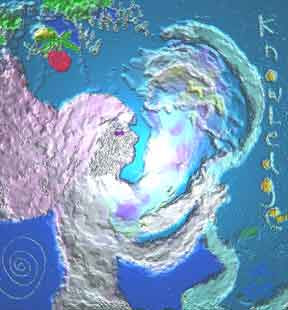
I chose this picture, though it has nothing to do with Santiago. It does have a lot to do with being willing to venture to unfamiliar places both without and within. Thank you, Mother Eve, for taking the first bite to a realized life.
We have been in Chile for just over a day. I'm sitting in an upstairs lobby of La Caja Roja, a hostel full of mostly young people from all over the world. Loud music is blasting from downstairs. Voices of guests eating their dinners on the patio blend in, along with clinking plates and laughter. Here, it doesn't feel I'm half a world away from winter, where the bells of my school ring, and my commute is driving up a mountain road. The Germanic orderliness that the United States possesses isn't found in Chile.
Bill and I stayed at this hostel for two of the weeks we spent here in July, so coming back felt like coming home in many ways. Out on the streets of the city, though, walking among the blankets spread full of bolsas and zapatos for sell, the crazy traffic, having a poor mother sing a song for some pesos to feed her baby, the reality that I have made a commitment to a strange new life is impossible to ignore.
Ice cream is a real highlight. It's simply wonderful, very similar to gelato. Most of the pastries, on the other hand, are heavy and unappealing-- which is a good thing because I have a weakness for them. I'd rather spend my dessert calories on the helados.
Took a trip to Vina del Mar today to rent a house that we found out about back home. Outside of Santiago, it becomes desert-like, similar to the few un-watered parts of southern California that remain. We passed chapparal and chemise, vineyards in the Casablanca Valley, slums on Valparaiso's hills.
Chile is a poor country with an expanding "middle class," however you might define it, and the wealthy whose homes could be anywhere in tonier areas of the states. Our new house is where a purse being snatched won't be out of the question, but that's probably the worst of worries. I wish my work clothes had deeper pockets to hide my i.d. and what little money I'll carry. I'll travel by bus or taxi to St. Margaret's, which has a gate models on Buckingham Palace, teaching girls who go home to fine houses, mas rica que mi casa.
I've stepped out of the "garden," of what I have always known, into a world where more knowledge and experience will be gained.
I need to work on my book, but so much nicer right now to put my thoughts here.
Tags: chile, hungry, la casa roja, teaching in foreign countries, vina del mar
Blog: Alethea Eason (Login to Add to MyJacketFlap)
JacketFlap tags: HUNGRY, Hero's Cycle, moving to Chile, middle grade science fiction, HUNGRY, moving to Chile, Hero's Cycle, middle grade science fiction, Add a tag

According to the Hero's Cycle, heroes need to pass through obstacles that guardians place before them in order to prove the heroes' worthiness to enter into the special world where the story will unfold. Guardians can be other characters, circumstances, or objects (locked windows). I feel that Bill and I are passing through our share of these guardians. To be cliched (as I am using Joseph Campbell's ideas here), we're "following our bliss" in our preparations to move to Chile. Daily we're coming up against a variety of guardians, but somehow a mixture of sheer willpower and serendipity are helping to dissolve them.
Some of these have been:
Reducing a household to four suitcases and a dufflebag full of bedding.
Luckily, we're not horders and have less to get rid of than most people. We're leaving some things: photos, some books, a few of my winter clothes as we'll be living in late summer in just a few days. It feels wonderful to let go. There are no family things on my side and only a few on Bill's, so this has been a blessing.
Dogs
The hardest part has been deciding what to do with our dogs. We can't take them now because we don't really know if this is going to work. Will we stay in Chile a few months or the rest of our lives?
We were going to have Lily, our 90 percent Ausie and 10 percent mystery dog, be our Chile dog at first. Then, we decided not to bring any of them. Then all of them. Then . . . We found a wonderful organization called We Care Animal Rescue in St. Helena, California. Through them, Lily found a home with a wonderful couple in the Sacramento area. As traumatic as it was for us to say good bye, Lily was won over by a chicken sandwich. She hopped in her new mom's car and off she went. She's happy. Got her teeth cleaned. Playing lots of fetch and going on oodles of walks.
Lily was a thirty pound whirlwind that kept Dazie wound up and puppy-like for six years. There was an amazing transformation from the very first day. Dazie came into her own and wasn't as fidgety, not even wiggling when I tried to brush her. So . . . we said, "Let's keep Wiley and her!" Friends tried her out on a sleepover to see how she'd do until we figured out how to do this, but on a walk in the hills above Upper Lake she got away.
I was taking Wiley to Petaluma for a potential foster mom to meet him when another guardian came my way. My wallet was stolen before I got there, so I had to return home to cancel things out. I got the message about Dazie. I left Wiley with some food because I hadn't fed him that morning (he gets car sick)and drove the hour to Upper Lake. We spent hours looking for her. She'd run off the road up a hill that was full of chemise, coyotes who'd come out at night, and that led into a wilderness area. I called and called her name at the spot she disappeared. She didn't answer. She could have been anywhere in rugged terrain. Bill was stuck in an elevator during this time (did someone say Mercury Retrograde?) and when he got home, he brought Wiley who only had to bark once for Dazie to answer. She was at the same spot I had yelled for her, but dog-to-dog communication won her over. Bill and Kenn then had to climb the mountain, though, and Kenn had to use all his forest service training to get through the brush. She wouldn't budge when he found her. She weighs 60 pounds and he dragged her through about ten feet of the chemise with her pissing and . . . you get the picture. Once she saw Wiley, she got up and trotted down the mountain with him.
We contacted We Care again for Dazie because we decided the move would be too much for her. The next day heard from a wonderful woman in Yountville (Napa Valley). We took Dazie to her house yesterday. She now lives on a 48 acre vineyard in a 5,000 square foot house full of comfy pillows and gourmet food cooked just for her. She'll eat plenty of fruits, vegetable, New York steak cut just right, and gourmet doggy biscuits. She'll also be taken out to a restaurant that gives the diners plates for their dogs, and back at home has a bidet for her very own to be able to drink fresh flowing water. I'd have felt guilty NOT to let her live there. I've always thought that our dogs had it nice. It's been boot camp for them in comparison! Though she did break our hearts. The two nights she was with us, she climbed into a suitcase to sleep.
What is wonderful is that both of the new families will let us know how Dazie and Lily are doing. We even have an invitation to stay in Dazie's paradise when we're in northern California. And through Dazie's little adventure, the people who were going to take her are now taking Wiley until we can figure out things. He is now the official Chile dog in residence.
However, contacting airline customer service to figure this out has turned out to be the most formidable of the guards at the "gate". I ended up screaming I WANT TO TALK TO SOMEONE HUMAN! When we got the humans, it was still difficult. We're still not sure what to do.
Car
No one wanted a Corolla with a stick shift even though we were offering under blue book. What about gas economy????? We were amazed. We dropped the price to way under blue book, and a woman from Willits called us. She was thrilled that our car even had old fashioned roll up windows. We've sold it at the last minute.
House in Cobb
The first people to look at our house are making an offer. HOWEVER, whether their offer is something we'll accept is another matter. We're free here, though, because through a conversation at the Mountain High Coffee Shop, serendipity allowed us to find a renter we can trust if the house hasn't sold by the time the listing runs out.
Home in Chile
Another conversation, at the Cafe Vasquez in Lakeport this time, has given us a fully furnished house to rent (with washer and dryer) in Vina Del Mar, twenty minutes by bus from where I'll work at St. Margaret's.
Work Visa
Last hurdle. By the time we got the documents we need, it was too late to process the visa up here. It will take the FBI four months to process my "rap sheet." Ah, let's see . . . there was a ticket on my way to church a few years ago for going a few miles over the speed limit. That must be what is holding things up. So, we're hoping we can process what we need to do once we're in Santiago. I only have a few days before I begin work, but not being anxious about this is a good lesson for me. If it doesn't happen, our journey may take off on a different path as happens in many good stories.
HUNGRY
Sales have been "quiet" according to my editor. Which means if things remain the same, the book I'm halfway through writing won't be wanted. I worry about the effect of being in Chile will have on my writing career. A friend suggested I blog on my webpage as Deborah in Chile, which I think is brilliant . . . the country's name allowing for a lot of puns with eating. I just hope I have time to do this. Anyway, I just have to believe that bliss and prayer and as much attention as I can put into promoting the book from down south will work.
I haved managed to sneak in a couple school visits through all of this: Lu Sutton School in Novato, where I saw again how much kids connect with the book. Also, another presentation on the Mendocino Coast at Horicon School in Annapolis, and the Four-Eyed Frog Book Store in Gualala. Grandmother Pig's Butt, my alter ego, is still training recruits for the great invasion of Earth, complete with an alien make over of a very brave volunteer. I hope she can somehow keep the training going in Chile.
Blog: Alethea Eason (Login to Add to MyJacketFlap)
JacketFlap tags: HUNGRY, blog tags. online connections, online connections, memes, HUNGRY, blog tags. online connections, online connections, Add a tag
You're It!
I’m tagging:
Norman Benson, forensic expert and author
http://timberbeastheartwood.blogspot.com/
Kim Baccellia , author
http://kbaccellia.livejournal.com/
1. How long have you been blogging?
I wrote my first blog post six months ago. I’m not focusing just on children’s literature, or teaching, or particular themes or issues. In a way, I guess I feel it’s more of an online diary. I’ve written about my book HUNGRY and trying to promote it, but my blog also covered my trip to Chile, reflections on lost family members, and whatever seems to be on my mind at the time I feel I like writing an entry. In the future, I hope to do a separate blog of meditations that I’ve written on the Major Arcana keys using a Christian interpretation of the Qabala. When I transferred computers, this was the one file that I lost. I’ve hadn’t had the time or the willingness to type over the meditations, but I figure they'll be a time I’ll just work on this project for a few weeks. I have an idea to do a painting or drawing for each meditation, but I rather doubt I’ll be this productive.
2. What inspired you to start a blog and who are your mentors?
Basically getting word out about my book inspired me. After creating my website, I found I enjoy working on web related things. I am very grateful to Janet Riehl’s wonderful listening ear, her explanations, and encouragement that allowed me to get started. I’m thinking especially of a walk we took last spring when I barely knew what a blog was. Another mentor is Norm Benson who showed me blogspot about the same time.
3. Are you trying to make money online, or just doing it for fun?
The hope is that my writing, Hungry, specifically, will be of enough interest for people to read my blog. I’ve never thought of money making online. I just hope that my book will sell enough copies that HarperCollins will want me to write another one, and if the blog helps with that, terrific!
4. What 3 things do you struggle with online?
I don’t know if I can separate this into three separate things. I get overwhelmed. Wonderful sites like Book Lust and Jacketflap have SO much information. I was recently sent an article about podcast that I haven’t read because I'm not in a place for a learning curve. It’s hard to take time to make connections. When I sit at my computer, I want to spend most of the time writing. I also don't want to spend my life on the computer.
5. What 3 things do you love about being online?
Email. I don’t really like using the phone, but I do love getting emails! Also, I appreciate how much easier the Internet has made the work of being a writer become. I used to feel isolated as a writer living in a small community. I feel the worldwide community now provides a sense of connectedness that, even ten years ago, I couldn’t imagine. Making friends with people I haven't met has been important, as well as having the ability to express my creativity and to get feedback about it worldwide.
Blog: Alethea Eason (Login to Add to MyJacketFlap)
JacketFlap tags: HUNGRY, moving to Chile, HUNGRY, moving to Chile, Add a tag
This is our phone, the one we use the most because we can actually hear people on it. We use our push button phone only when we need to. Bill found this in a shed at his mother's house about thirty years ago. Who knows how long it had been in there?
A friend's daughter wanted to call her dad one day and after she picked up the receiver she just stared at it, not knowing what to do. I realized that it's probably the equivalent to the pictures I saw of hand crank phones when I was a kid. I wish we could take this beauty with us!
I've been offered a job at St. Margaret's British School for Girls in Concon, Chile. A part of my day will be spent teaching high school English! Because the academic year in Chile starts in March, I'm hoping to leave my current job by mid-January and be in Chile sometime in early February.
Bill is working very hard to make our house look like a million dollars (we wish) to be ready for possible buyers. I'm trying to find a qualified teacher to finish out my contract year. We need homes for two of our dogs. We're bringing Lily, our oldest and most adaptable as our Chili dog. Our hearts are breaking over the other two. Dazie, though, will be happier in another home without the other two dogs bothering her. For some reason she offers a type of alure to both Willy and Lily. They never leave her alone! Willy is everyone's boyfriend. He's affectionate and goofy and totally loving (a quality Lily doesn't always possess).
We could be there a year, but we could also be there the rest of our lives (with trips home, of course.) We'll be living by the sea in a climate similar to Santa Barbara's. Vina Del Mar, a tourist destination, is only a few miles south and offers plenty of shopping opportunities if we need them and great food. Valparaiso is half an hour farther south and is a wonderfully atmospheric bohemian sort of place.
I have a dream of an ex-pat community of friends in Concon! We hope to receive many visitors over the years.
Blog: Alethea Eason (Login to Add to MyJacketFlap)
JacketFlap tags: HUNGRY, healing from grief, HUNGRY, healing from grief, Add a tag

.jpg) I wanted to write this entry earlier in the month, but I've finally got started on STARVED and didn't want anything to get in the way. Writing seems to be coming FINALLY, and the story that's emerging feels right.
I wanted to write this entry earlier in the month, but I've finally got started on STARVED and didn't want anything to get in the way. Writing seems to be coming FINALLY, and the story that's emerging feels right.
Daddy, the stars fell when you died, skidding across
The creosote was drunk in the dry desert air.
And though I wasn’t there,
leaving your daughters like thistles blown over the chaparral,
our breath thin as the stems of the palo verde
The house filled up with uncles. My boyfriend and I slept
I was numb like the space between stars
of broken glass falling to earth in silent breaths.
Daddy, thousands of stars have tumbled since then,
streaking through the heat of a hundred nights.
have burned open the portion in me that closed
more than twenty years ago.
save for the drink of starlight and the odor
of yarrow and summer grass.
Of star flakes nor the earth of burning sand.
You were carried by the wind luminous across the sky.
Madonna is all dolled up. Her glittery eyes
her sparkling gaze, too quiet for a party,
In the other picture, four dancing girls
far from the bad manners of these sweaty men.
In the morning, I look through my scratched lens
and sit with Andrew as he drinks chocolate milk.
Must I meditate on death with this child at my desk?
On the decal of the shuffle skeleton on the car I passed?
The white rose so quietly growing on the vine?
My sister drowns in a hospital room.
divas dance on the walls.
speak to her of heaven. I pray her rose unfurling.
Her wings ribbed with glittery adornments.
I think of deserts carpeted with red flowers,
and unfolding. I write HEAVEN in my book
Blog: Alethea Eason (Login to Add to MyJacketFlap)
JacketFlap tags: HUNGRY, Coquimbo, travel in Chile, HUNGRY, travel in Chile, Coquimbo, Add a tag
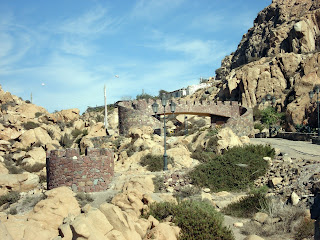
We had great empanadas here!
I want to end my Chile journal with a view of the rocks in Coquimbo. Not far from here was the Escuela de Juan Pablo Segunda and the homes of its students.
People keep asking me about Chile. The strangest question was: Do Chileans sleep in beds? Duh.
Chile is TEMPERATE with little humidity, which as Californians we really appreciate. The country is striving toward modernity and is a first world nation in many aspects. In Santiago, we were told there's an effort to create medical facilities that equal Johns Hopkins. (Will everyone be able to use them? No. Does everyone get to go to Johns Hopkins in the United States?)
We just explored the north on this trip, as it was winter. As I'm sure you know, Chile extends far to the south where the terrain and climate match that of Oregon, Washington, and British Columbia. Easter Island and Robinson Caruso Island far out into the Pacific also belongs to Chile. The Argentinians may disagree, but Chile claims the most southern city in the world, Punta Arenas. The country even has authority over a wedge of Antarctica!
Once again, I'll refer to what my husband says about the country: Chile is experiencing it's springtime as a nation. There are challenges, and I'm sure if we take the plunge and move we'll have many of our own. I'd like to thank my friend Debbie Southworth for writing, "You may be giving up things, but think of what you'll be gaining!"
Please come to visit when we're official residents of the southern hemisphere and discover for Chile for yourself.
Blog: Alethea Eason (Login to Add to MyJacketFlap)
JacketFlap tags: HUNGRY, Coquimbo, travel in Chile, HUNGRY, travel in Chile, Coquimbo, Add a tag
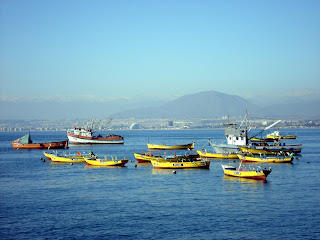
Here is a view from the harbor in Coquimbo, looking across the bay to La Serena. If you squint, you can see the condos on the far shore. A lot of condos in Chile are in Soviet style, but a few, like those in Vina Del Mar, have more architectural flare.
So, this is where the pirate children live, the corsarios. Coquimbo has a Valpo feel, more frenetic than La Serena, a little more edge. Near the harbor, there's a section of town called El Barrio Ingles (sorry for no accent) where we were told great music was to be had.
Blog: Alethea Eason (Login to Add to MyJacketFlap)
JacketFlap tags: HUNGRY, travel in Chile, La Serena, HUNGRY, travel in Chile, La Serena, Add a tag
 One of my favorite things I heard in Chile was a question asked by a young woman from England who had just arrived at La Casa Roja: "Are dogs sacred here?"
One of my favorite things I heard in Chile was a question asked by a young woman from England who had just arrived at La Casa Roja: "Are dogs sacred here?"
Though I chuckled when I heard this, I thought later, "Well, yes." They're everywhere. This guy in front of a pharmacy, for example. All of the ones I encountered were well fed and not aggressive, though I sure didn't try to pet any.
One day, coming back from lunch in the downtown area of La Serena, five big dogs followed me back to Maria's Casa. The walk was at least a mile. "Hmmm," I thought. "I have some friends." Of course, they were following the chicken scent on my hands. I'd cross a street, and they'd follow in their pack. I was quietly panicking, but when I turned down the street the hostel was on, several very small dogs came out barking from different doorways. The big dogs ran away.
It was heavenly to fall asleep without the sound of traffic and car alarms. Quiet, except for our last night there. There was a soccer game in the stadium behind the hostel and a continual cheer lasted for about four hours.
Blog: Alethea Eason (Login to Add to MyJacketFlap)
JacketFlap tags: HUNGRY, La Serena, Maria's Casa, Chile, HUNGRY, La Serena, Maria's Casa, Add a tag
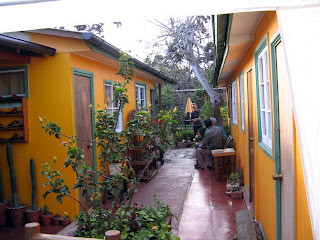
After the Yo Yo, Marie's Casa (and that's what the sign said, not La Casa de Maria as the cab drivers would know it) was marvelous. Clean. Fresh. BUT COLD. This is where the really cold weather hit and nights were nippy! The computer was outside so fingers were freezing as they were typing! Plus, I caught a cold that I passed on to Bill the following week.
The picture above is of Pancho who is a shoemaker. He has a shop at the hostel. There's Bill, too. Pancho is fixing Bill's belt. Just as the Lonely Planet Guide Book says, Maria clucks and sweetly frets over all of her guests. Andres picks you up at the bus station if you let the hostel know you're coming, but its only two blocks away. Olga, the housekeeper, and I really bonded, as I did with Nichole, a German engineer and a frequent guest, who works on water issues in the region. It was very hard to say good bye because we were made to feel like we were home.
Blog: Alethea Eason (Login to Add to MyJacketFlap)
JacketFlap tags: HUNGRY, travel in Chile, El Gato en La Ventana, Valparaiso, HUNGRY, travel in Chile, El Gato en La Ventana, Valparaiso, Add a tag
Our Room at the Yo Yo
We do live it up, don't we?
Believe it or not, I have fond memories despite the bad bed and the mildew. Bill thinks he got flea bites. VERY nice people, though. Lisa from Scotland, a Spanish teacher, spending her summer break working at the hostel and in Valparaiso. There was Hoss and Jamie, two American teachers, becoming sweethearts; and Roberto, the man on the midnight to dawn shift, polite and helpful, offering tea and calls to taxi cabs in the early morning hours after we'd gone to the folkloric club. We didn't want to go to sleep in case we might miss the 6 a.m. bus to La Serena.
We went back to Valparaiso and the club just before we left. After a taxi hurled us through the streets at 4 a.m. to find the bus station was closed, where else would we go to share a couch and have a blanket put over us?
Valparaiso is a small city just south of its more refined cousin, Vina Del Mar. I loved it: bohemian, artistic, a bit seedy in spots, hills to climb like in San Francisco, breathtaking views, glorious architecture, music, and murals. The helado (ice cream) in Chile are delicious everywhere, and are much like gelato, but the portions seemed to be extra big in Valpo.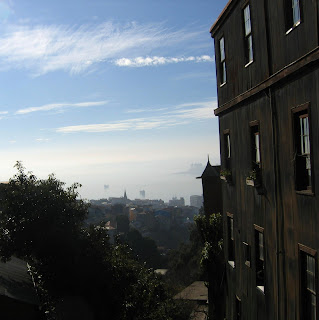 See what I mean about the view?
See what I mean about the view?
A photographer's dream. Everywhere you look, scenes perfect for pictures.
We climbed to the top of the town, back down for lunch, then up another steep hill to Neruda's house. There are ascensores, funiculars to help with the hills. We just never came across one. Probably a good thing considering the helados.
Many street vendors, more great alpaca sweaters and hats. Families shopping on downtown every night until nine o'clock. We were warned that Valparaiso was dangerous. If we had gone down certain streets at night, it probably would have been. Well, I wouldn't walk through the Tenderloin at 2 a.m either.
On the nights we went to the club, young people were still on the street when it let out, no doubt wondering who these old farts were. Both times we came back to the Yo Yo, a charming young French woman was cooking (so sorry I haven't retained her name!). The first morning she was baking a tart; the second morning she had potatoes in a pot for gnocchi.
If you go to Valporaiso, please go to El Gato en la Ventana. It's on Simmons, up the hill just a way from the main streets, on the left. It doesn't open until ten. Music starts between midnight and twelve thirty. If you order a cuba libre, you won't get a lime. Instead your glass will be filled a third of the way with rum. Good thing, too, because it was cold until the dancing started. If you don't smoke, well . . . I kept telling myself that one night of inhaling probably wouldn't kill me. There was such joy in the room. Live for the moment!
The audience joined in traditional songs and danced euphorically as the night went on. The music is mostly acoustic and loud. The musicians are incredibly talented. Definitely, a night to remember.
Blog: Alethea Eason (Login to Add to MyJacketFlap)
JacketFlap tags: HUNGRY, travel in Chile, teaching opportunities in Chile, HUNGRY, travel in Chile, teaching opportunities in Chile, Add a tag
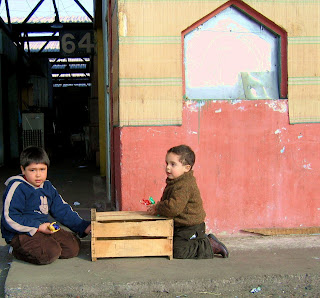 A year ago I sent out around thirty applications to various teaching positions in southern California to try to find work closer to where my mother lives. I heard back from two, one in Thermal, and the other, an administrative position in Indio. I think both places reached 127 degrees the summer of 2006.
A year ago I sent out around thirty applications to various teaching positions in southern California to try to find work closer to where my mother lives. I heard back from two, one in Thermal, and the other, an administrative position in Indio. I think both places reached 127 degrees the summer of 2006.
I'm far from fluent in Spanish, and I've been teaching a long time. Perhaps this is why I didn't get responses, but schools in Chile wanted me, and every school I visited welcomed my teaching skills with open arms.
Before I left, I researched several places and set up entrevistas. The first interview was at private school, Santiago College, which invited me back to teach a lesson in phonemic awareness to third graders. I also visited a fourth grade class and talked about California and my novel HUNGRY. I was given the Chilean hello upon my second visit, touching cheek to cheek with both the director, Sra. Farba, and the curriculum specialist whose name was Susanne, if I remember correctly. They were amazed that in California we teach EVERYthing: art, music, p.e., on and on and on . . .
I followed this interview with another at the Universidad de San Sebastien, within walking distance from our hostel. On his trip to Chile earlier in the year, Bill had talked to Sra. Pichilaf, a professor there, and found out about the commitment the country has made to teaching English. American English, at that. I don't have a master's degree, but I do have over twenty years of teaching at Title One schools and two credentials. I was offered a job to teach writing, English, and reading pedagogy to university students enrolled in the education department. San Sebastien was the first of many brand new schools Bill and I saw. The students who go to it are from the public school system, and many are the first generation in their families to have an opportunity to get a degree.
We then visited with Mr. Donald Bergman, the director of Nido de Aguilas, the American International School in Santiago, considered to be one of the most prestigious in the country. The atmosphere of the office made me feel I was back home. Half of the students are Chileans, the rest are children of diplomats and foreign business people. As an international school, representatives come to various hiring fairs in the United States. There is one in San Francisco in the spring. It's important to know that to receive a higher salary, you should be hired at one of these fairs. If I chose to work at Nido, I'd go to the San Francisco fair and make the job official this way.
I work with a Chileana, my good friend, Veronica McGee. She suggested we go to Lincoln International School, as she worked there in the 1970s. We mentioned her name to the director, Mr. Seaquist, and a big grin spread across his face. Veronica had been his teacher! Mr. Seaquist offered Bill and I both positions, starting whenever we could move to Santiago. Lincoln is a small school, which I liked a lot. Students are taught in English through the 6th grade (maybe the 8th? can't remember), and then they are taught in Spanish. I found this to be a common practice, as students need to pass the national exams to be able to graduate.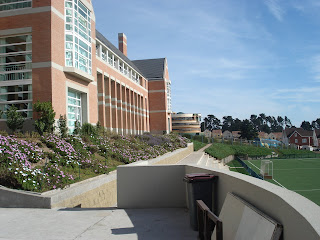 St. Margaret's British School for Girls is in Concon, a couple hours north of Santiago near the city of Vina Del Mar. (I apologize for writing "n".) I felt like I had walked into a spa. The school is bright and shiny and new. Every classroom has a view of the ocean. In emails to friends, I compared the view to that of Fort Ross on the northern California coast. The director, Sra. Avril Cooper, was warm and was thrilled when she found out I was Anglican. The student population consists of all girls, from kindergarten to 12th grade. The school is committed to the International Baccalaureate Program and sends its teachers to England to be trained.
St. Margaret's British School for Girls is in Concon, a couple hours north of Santiago near the city of Vina Del Mar. (I apologize for writing "n".) I felt like I had walked into a spa. The school is bright and shiny and new. Every classroom has a view of the ocean. In emails to friends, I compared the view to that of Fort Ross on the northern California coast. The director, Sra. Avril Cooper, was warm and was thrilled when she found out I was Anglican. The student population consists of all girls, from kindergarten to 12th grade. The school is committed to the International Baccalaureate Program and sends its teachers to England to be trained.
The last school I went to was a complete surprise. Seven hours north of Santiago are the sister cities of La Serena and Coquimbo, which I plan to write more about. In Coquimbo, however, Bill was walking around in a stunning area that looked like Joshua Tree by the sea: beautiful boulders rolling down to crashing waves. In the U.S., this place would have been gobbled up by millionaires long ago, but it's one of the poorest places in Chile. Here, he found a brand new school which looked very much like St. Margaret's with the same panoramic view of the Pacific. He thought it was a private school. I went back with him the next day, and the welcome we got, two Americans just wandering in, was one of the most amazing experiences of our lives.
The school's name is Juan Pablo Segundo, but even though it's named for a pope, it's a public school. The Chilean government has spent three million dollars on new schools for the area. I brought my resume along, just in case. We told Verela, the English teacher at Juan Pablo, that we were visiting Chile and were considering moving to the country. She told us I could start work immediately if I wanted to!
Many of the children at the school are descendants of English pirates, the corsarios, who with Francis Drake used Coquimbo as a port to raid Spanish Galleons. There were many children with fair skin and freckles. Juan Pablo Segundo is two years old, and this is the first time the children had even gone to school. The first thing they had to learn was how to use a bathroom, as they used the Joshua Tree like rocks around their homes before. The teachers are highly dedicated. They say that the kids can be challenging at times, but that they are sweet. They and their families are incredibly happy to have the gift of education finally given to them.
We were invited to come back for a tea, a celebration for the three students with the highest grade in each class. While we waited, the president of the school, a charming 7th grade girl welcomed us in her very best English, while other students huddled around with pretend microphones as though she were interviewing us for television. The tea was delicious, along with sandwiches and cake, and we were told to go to the Education Department in town and drop off another resume. We did this the next day, and I'm proud to say our Spanish was good enough to get us pass the security guard and to communicate with a secretary about why we were there.
So many opportunities boggled us. We're still sorting things out. Coquimbo has its charms, and it's cheaper than Santiago. In La Serena, we found lunches for $1.60, where comparable lunches in Santiago were around $3-$5 dollars. I love being near the ocean, and Coquimbo/La Serana offer this option. Santiago, though, offers more varied opportunities, closer to the airport for trips back home, and living in a city would be so different from our life in rural northern California. We go back and forth and back again, able to imagine an array of permutations for our future.
Then . . .
On our last day, Bill and I were making last minute shopping choices (and, boy, do I wish I brought home more sweaters, scarfs, and shawls to give as presents). We were standing next to a stall with mugs with Allende and Pinochet's faces on them. Mugs on mugs, I guess. The vendor was putting her finger to her throat, indicating what Pinochet did to Allende, and Bill made a comment about how, perhaps, Pinochet's portrait should be on a chamber pot. He started talking to a gentleman standing nearby who laughed heartily at the joke.
Mr. Mattus is an epidemiologist who works at the World Bank in New York. His wife is the Chilean ambassador to Peru. He found out that I taught, took my name, and gave it to a friend who is a professor at the Preuniversitario de Chile, a feeder school to the Universidad de Chile. Yesterday I received an email and was offered a position to teach IMMEDIATELY!
Ahhhhhh!!!!! We have to sell the house in a depressed housing market. We have three dogs. I have to focus on writing, and school will start again here in California before I know it. But I think Chile is calling us, and in a year, we may be there.
Blog: Alethea Eason (Login to Add to MyJacketFlap)
JacketFlap tags: HUNGRY, travel in Chile, Santiago, Chile, HUNGRY, travel in Chile, Santiago, Add a tag
 Here is my husband Bill, self proclaimed barbarian, playing guitar upstairs at La Casa Roja. Notice the high ceilings. The hostel was once a mansion, and Simon, the owner, has worked hard to restore the building and to provide all sorts of services for its guests, including ski trips to the Andes.
Here is my husband Bill, self proclaimed barbarian, playing guitar upstairs at La Casa Roja. Notice the high ceilings. The hostel was once a mansion, and Simon, the owner, has worked hard to restore the building and to provide all sorts of services for its guests, including ski trips to the Andes.
I was amazed at all the young people from England, Ireland, Australia, and Germany who are traveling around the world. It seems to be a rite of passage to finish school, or take a break during college, and to get a ticket that allows them to stop where they like, as long as they keep going in the same direction. There were VERY few Americans and Canadians, and the ones we met were generally a bit older, often teachers visiting Chile during "summer" break. I loved hearing different languages spoken as I'd walk through the halls. Snowboarders from Spain next door to our room drunkenly sang in Catalan a couple of nights. Very rowdy, but nice young men, all the same.
Most of these young people were visiting many of the countries in South America. A young woman from Israel volunteered at an animal sanctuary in Bolivia. On Bill's trip in February, he met a Danish woman who had worked at the same place whose responsibility was to walk a puma on a leash through the rain forest. Traveling from hostel to hostel, friendships are made; people meet up with each other quite frequently. Going to Bolivia seems to be must do, as well as Peru. I heard wonderful things about countries like Colombia, where I'd be hesitant to visit. A young woman from Australia said it was her favorite country and "only heard gunfire one night in my hammock."
According to the Lonely Planet Guidebook, Santiago is one of the safest big cities in South America. In certain areas, "starving students" might ask you to buy a poem that they have "written." Be aware. Take pictures, but don't be flashy as a tourist, and chances are there won't be any hassles.
The city rises on a plain up to the foothills of the Andes; the higher in elevation, the more wealthy the neighborhood. The Barrio Brasil, where we stayed, is near Santiago Central, and long ago was where the wealthy lived. Over time, it fell into decline, but now it's experiencing a revival, kind of a South of Market thing that has happened in San Francisco. I grew to love it because of the atmosphere of the neo-colonial buildings, the energy of the university students who seemed to be everywhere, the wonderful park where children played late at night, and the coffee we found in cafes.
Bill and I probably walked at least five miles a day. We'd head from La Casa Roja to Central where the Palacio De Moneda, the presidential palace, is. The financial sector and shopping areas are found here, too. I felt I was in Europe as I walked along the streets. By the way, street vendors sell wonderful sweaters, shawls, and scarves made from soft non-scratchy alpaca, as well as jewelry, often made from lapis lazuli.
We strolled down the Ahumada, a pedestrian thoroughfare full of stores, street vendors, musicians, and acrobats to the Plaza De Armas. The first day we were there, there was a gay pride celebration with a drag queen singing. Another time, there was traditional music and dancing, and the last visit we listened to the band of the Carboneros, the Chilean police.
We walked through the Mercado Central. The first building was a fish market, with restaurants. Acres of fish of all sorts. The second building had acres of fruits and vegetables. Cutting through Bellavista, we ended up at Cerro San Cristobal, the highest point in the city. This is a view of Santiago from an funicular that takes people almost to the top.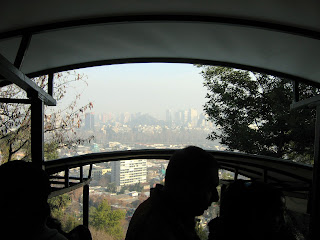
Can you see the smog? The first day I was there, I could taste it. It reminded me of growing up in southern California, but winter is the time of the year when smog gets worse. I joked that it was a southern hemisphere phenomenon where things were opposite from California. Actually, the Andes are so nearby that the cold air doesn't rise, but gets compacted in the basin. Smog settles in. Unless it rains, that is. Right before we left, a cold front came through, leaving snow in Lo Barnechea, the highest part of the city. Our last day was glorious: crisp air, bright blue skies, and I felt I could reach my arm out to touch the Andes.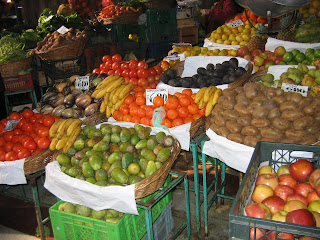 (Here's a shot from the fruit market. Bill bought a kilo of kiwi for about 250 pesos, about 50 cents.)
(Here's a shot from the fruit market. Bill bought a kilo of kiwi for about 250 pesos, about 50 cents.)
We climbed to the top of San Cristobal. I went into the chapel and said a centering prayer while Bill waited for me. Good thing because we then rode down the mountain in a sky bucket, a long steep ride with a magnificent view which I enjoyed as I clasped my seat with an iron grip.
Then we "landed" in Provedencia and took the subway back to Barrio Brasil. Over a million people a day ride the subway in Santiago. It's a great way to travel during off-peek hours, though I practiced breathing calmly during rush hour when we were squished. BUT that brings me to one of the things I loved the most. People were unfailingly polite. I loved hearing the gently sound of "permiso" as people squeezed through others as they got off.
Graffiti was everywhere. I started to look on the it as art, but one of the biggest pleasures was turning a corner and finding wonderful murals like this. The Bellavista area, in particular, abounded with houses that were true works of art.
Bill frequently mentions that Chile is in its springtime. Chile has the highest standard of living in South America; though poverty is a still an issue, the country has recovered from it's dark era of repression and is going at full throttle to take its place as a modern democratic country.![]()
Blog: Alethea Eason (Login to Add to MyJacketFlap)
JacketFlap tags: HUNGRY, travel in Chile, teaching opportunities in Chile, HUNGRY, travel in Chile, teaching opportunities in Chile, Add a tag
.jpg) In America, airports screen for terrorists, but when we arrived in Chile, our luggage had to be x-rayed in case we were smuggling in cheese. So, on top of my list for moving there is the lack of fear and threat. I don't believe that Chile is anyone's enemy right now, though I heard that Bolivia is still upset about losing their coastline during the guano wars in the 1800s.
In America, airports screen for terrorists, but when we arrived in Chile, our luggage had to be x-rayed in case we were smuggling in cheese. So, on top of my list for moving there is the lack of fear and threat. I don't believe that Chile is anyone's enemy right now, though I heard that Bolivia is still upset about losing their coastline during the guano wars in the 1800s.
I've been home for three days, reveling in the green of summer, the order and luxury of the United States. Ah, warm water in sinks and plenty of toilet paper. But spending a month in South America was heavenly, and it is increasingly looking as though we're destined to be there.
I could forget about the war for awhile, be touched by the kindness of the people we met, wooed by the romance of the neo-colonial architecture, and overwhelmed with options offered to me as a teacher.
I'd hoped to blog, but computers were busy in hostels, always with someone else waiting for their turn. Dealing with a Spanish keyboard and needing to write fast made me decide to wait until I came home. Speaking of writing, as in fiction projects, I didn't do that either. I brought an Alphasmart with me, a small lightweight word processor, but I found that it didn't cut and paste. I can barely write a sentence before I'm rewriting. The three or four times I sat down to work, things didn't flow.
Hostels in winter evenings are cold. Few people in Chile have heat beyond kerosene. There's no natural gas in the country, and South America has been experiencing the coldest winter in 90 years. Also, good light was hard to find in the evenings, and my eyes need it.
Excuses, excuses.
The day before I left, I worked with my writing partner Mary Benson on the plot for STARVED. I told her I'd be happy if I brought back 30 pages. Well . . . my subconscious usually solves manuscript challenges if I leave things alone for awhile; perhaps letting go of the pressure to write the second novel that I need to write was a good thing.
I did read A LOT, something I often don't find time for. Five novels, which were like candy: The Subtle Knife and The Amber Spyglass by Phillip Pullman which pulled at my heart and kept me thinking, the first Sally Lockhart mystery also by Pullman, Ann Rice's Jesus the Christ, and Pharaoh by Karen Essex, wonderful to read on frigid days in July. Snowmen on the July pages of calendars might be something I never get used to.
The picture above was one of my favorite places in Santiago, a historic square near our hostel, La Casa Roja. La Casa Roja run by an ex-pat Aussie named Simon, has the reputation of being the best one in Chile, and comes with a Dalmation named Dado who has his own couch.
I freaked when I got there, though, mostly due to travel fatigue. So many people were smoking, the area around the hostel didn't look safe (although I saw hundreds of university students and women walking alone), and I realized that I wasn't going to be warm for a month. Needless to say, I got over it, and by the time I left Bario Brasil felt like home.
Blog: Kayleen West (Login to Add to MyJacketFlap)
JacketFlap tags: blind art, visual impared, angles, Anddy lakey, Add a tag
Coincidently on the radio (Light FM) today they were interviewing an industrial design graduate Vanessa Murby who is blind. I was intrigued how blind people can be so much a part of the visual world. They can not only be part of it but also be proficient. She uses power tolls and computers. Technology has advanced to such a degree that blind people can participate with the visual world so much
Blog: Alethea Eason (Login to Add to MyJacketFlap)
JacketFlap tags: HUNGRY, Hero's Journey, Myth and the Movies, plot, HUNGRY, Hero's Journey, Myth and the Movies, Add a tag
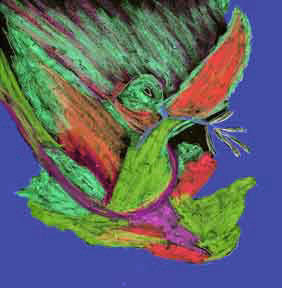 Today I was determined to get a new entry written and then work on subplots for STARVED. Here it is, though, past 10:30, and I'm just settling down to work. I had to contact a representative from an educational publishing company to get copyright info on a math problem that I found on the web for HUNGRY. I got a letter from him last year, but there was some technicality to look into. So . . . behind schedule!
Today I was determined to get a new entry written and then work on subplots for STARVED. Here it is, though, past 10:30, and I'm just settling down to work. I had to contact a representative from an educational publishing company to get copyright info on a math problem that I found on the web for HUNGRY. I got a letter from him last year, but there was some technicality to look into. So . . . behind schedule!
Much of my energy this week has been spent packing for our trip to Chile (leaving soon!) and working with a district committee to hammer out our English Learner program (dealing with boring stuff like forms, so all the schools in the district are on the same page).
Back to plotting: as a writer, plot is the hardest thing for me to deal with. I do outline after outline, but what seems to be logical often doesn't work when I'm actually trying to write. My good friend and mentor Bruce McAllister (a great writing coach: http://www.mcallistercoaching.com/) suggested I get the book Myth and the Movies, by Stuart Voytilla and study how the hero's journey, the archetypal "template" that all good stories follow, is applied to various film genres: science fiction, thriller, romance, romantic comedy, history, etc. The process works just as well for all stories: movies, novels, short stories.
I find that I don't enjoy a lot of movies anymore because I know what's going to happen: toward the end of the movie, the protagonist gets his or her reward which signals that the biggest hurdle is on its way. I was a little reluctant to use the process when I first read the book. Now, though, looking at it again after a year, I see what a powerful tool it is.
I've drafted the main plot of STARVED (at least I've done a first run of it) on a circle chart using the elements as described in Myth and the Movies: starting in the ordinary world, encountering a mentor, refusing the call to adventure, accepting it, crossing the threshold to a special world, facing tasks, symbolically dying through an ordeal, coming back into the ordinary world with a reward, being resurrected on the road back to the ordinary world, and returning with an elixer. There is also a character arc that correlates with plot points. Having this structure really did make the story I want to write easier to conceive.
I want to do the same process with the two subplots for STARVED later today. All three circles (or more if I have time to do character archs) will go with me to Chile. I work best when I give myself deadlines, so I've promised myself that I'll have a strong beginning for the book before I return.
Since I write about the hero journey today, the peace dove is for the young men and women in Iraq. I hate this war and don't believe in it, but my heart goes out to those who are in the middle of it. I just heard that one of my former students is headed for the army. I know that there are many kids I used to teach over there. I wish them safety, a swift return home, and peace for everyone in that tattered country.
Blog: Alethea Eason (Login to Add to MyJacketFlap)
JacketFlap tags: HUNGRY, violent media and children, Add a tag
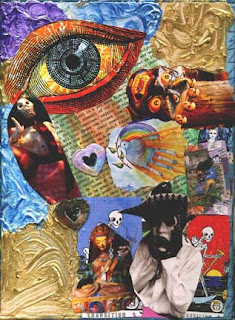 Earlier this year while deciding which DVD to rent at the video store here on Cobb Mountain, I watched a family out of the corner of my eye while they were making their decision.
Earlier this year while deciding which DVD to rent at the video store here on Cobb Mountain, I watched a family out of the corner of my eye while they were making their decision.
Dad and Mom, a boy about ten, and a younger boy who was probably five or six, wandered in and out of the rows. I think what caught my attention was the affection the parents had for their boys. To my surprise, the movie they decided to watch (family consensus) was SAW 2.
The day before I'd taught a writing lesson to first graders. The objective was to write using sensory details. The classroom teacher suggested that the students write about a dream they'd had. One child volunteered that Chucky was in his dream, and then one child after another talked about Chucky showing up in theirs. Chucky's one busy boogeyman. I asked the class how many of them had watched a movie with Chucky in it.
All but one or two kids raised their hands; even the sweetest little girls who usually wrote about rainbows and ponies were enthusiastically waving, wanting to share their favorite scenes.
I don't have children, but I have a feeling I'd be "old fashioned" about what I'd let my six year old watch.
At the video store, this was on my mind as I watched the family happily leave with SAW 2 tucked under the eldest son's arm. I rarely speak my mind in public, but maybe because the lesson was had just happened, I made a comment to the owner of the store about the purchase.
A man standing behind me overheard and asked, "How old is old enough for kids to watch horror?"
Taken off guard, I said, "I don't know. Twelve?" (If I had had my wits about me, I'd probably have said an older age.)
He stepped forward and pointed his finger at me, "You're saying my 11 year old isn't old enough to watch Saw 2?"
I told him my story about the first graders, and he then asked me,"But weren't they giggling?"
At this point I was almost in tears, but I managed to sputter, "Yes, they were . . ."
In a louder voice, the man asked, "And so what's wrong with it?"
I tried to say that I felt kids are growing up too fast, that I wanted them to be innocent for as long as possible, that I hated for kids to become inured to violence, having graphic violence implanted in their brains from the time they're born, and how hard it has been at times to get certain students to write something that doesn't come canned out of a movie script with heads blowing off right and left. I wanted to tell him about my worries about our society becoming desensitised to violence. I wanted to site studies about how video games have been linked to acts of violence among young men, and the anger and dread I felt when I read about how players get more points in Grand Theft Auto from shooting prostitutes after raping them.
I was flustered and couldn't talk. I managed to pay for my movie and got out of there. Then driving home, I thought about HUNGRY. Okay, here I was upset about SAW 2 and Chucky inhabiting the dreams of first graders. . . and what had I written? Deborah and her family eat people, for goodness sakes! Does the humor justify the violence in the book?
When I was writing the novel, I didn't take the Jones family dietary habits seriously because of the humor, and I didn't think anyone else would either. Willy, Deborah's best friend, and his parents are into horror movies, but when I was thinking classic horror, like Dracula and The Birds, (a movie I wasn't allowed to see when I was six or seven.) Deborah struggles with her family and culture's idea of what makes a good meal, so will kids see the importance of this?
I hope so. I hope the novel will put what is gratuitous in context and will give the little Estefanies and Gabriels a point of reference as they grow older, that they'll understand Deborah's delimma, and not just get off on the feeding she does.
Did the parents of the boys I saw in the video store talk to their kids about what they were watching after Saw 2 was over? I hope so. I hope parents will take to their kids about HUNGRY, as well.
Blog: Alethea Eason (Login to Add to MyJacketFlap)
JacketFlap tags: Chile, home, HUNGRY, Add a tag
I've been craving chocolate. Grumpiness level moderately high. Fell asleep yesterday at four p.m. and slept (almost) through until six this morning. Sure signs summer vacation is sorely needed.
Bill's hammering, putting stained glass panels above our sink. He's been painting our house white and laying paving stones and redoing the deck. Working on the house in case we decide to move. We're off to Chile later this month to see if I fall in love with the country as much as he did when he went earlier this year. I haven't put away my winter clothes. The temperature in Santiago was down to freezing last night.
If we decided to live in Chile, it won't be for at least another year, though the changes we're doing (I'm using the royal "we" here, as Bill's the craftsman) will make it hard to give up this place. I found the countdown clock for my novel HUNGRY on my HarperCollins' page this afternoon, and I only have a millions things to do before October!
I'm a fretter by nature. Will kids really like the book? Will some parents be concerned their children are reading about a girl who might have her best friend for a snack? As charming as I think Deborah is, will others feel the same way?
At my church (come on by: http://stjohnslakeportparish.googlepages.com) or at meetings in the diocese, people ask me what the book's about, and I say, "Flesh eating aliens;" no one has crossed themselves or pulled out a crucifix. So far everyone has laughed. I always add: HUNGRY is about a girl who has to struggle with the values of her home and culture and the difficulty of doing the right thing.
I'm glad we're going away. Working on preparation for the publication in Internet cafes in South America probably is the best thing that could happen to me! Plus, I'll be in a new atmosphere to start seriously writing a new book.




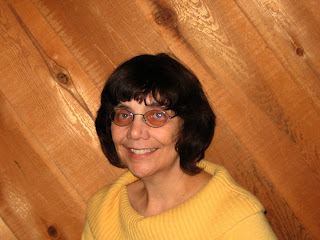
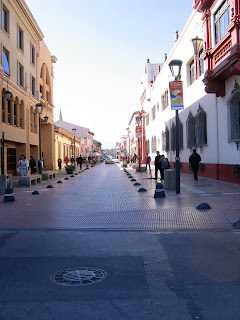
I google searched "Rowntrees Tiger Tots" and your blog was the forth entry. :-D
Success at last. :D
Ooohh...I love Dolly Mixtures.
Last time I was in the UK I was dismayed that I couldn't find Caramac bars any more. Loved those, even if I may have spelled it wrong...
Oh, we still have those. I'm sure I've seen them somewhere.
Woot on the story!
I wish soda tasted the way it did when I was a kid : P American soda tastes like a sweaty ballsack these days.
I have never had these Tiger Tots, but your post has convinced me I might like some too. And now they are not only extinct, but never even existed on my side of the pond! WAAAAUGH!
I'd never heard of Tiger Tots or a Dolly mix. I think we call them party mix over here, not sure. I'm more of a Cheezels/potato chip fan.
Natalie, I'm lucky, I never have liked soda.
Katey, if I ever time travel, I'll send little you a packet.
Danielle, my tooth is far too sweet.
Good luck on the time travel story!
Did you get your Tiger Tots yet? Those future time travelers are such slackers.
I miss flavored Tootsie Rolls from my childhood, but at least they still make them. They're just really hard to find and you have to buy them in expensive packages of mixed candy, then pick out the good stuff.
Kate :( or maybe :) - because if I did get them, maybe said time traveller made me sign a contract to say I never did.
I googled "Rowntrees Tiger Tots" for the heck of it, and yours was the sixth hit.
At any rate, I'm saving my time travel technology for Patton Oswalt, so he can go back in time and beat George Lucas to death with a shovel. :)